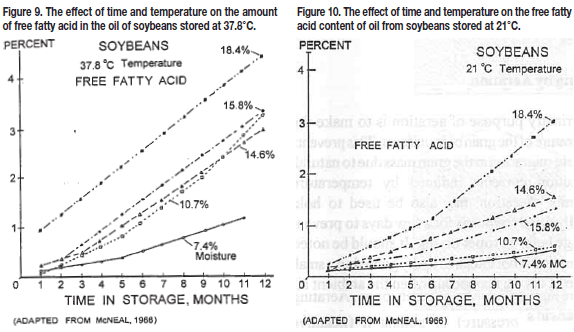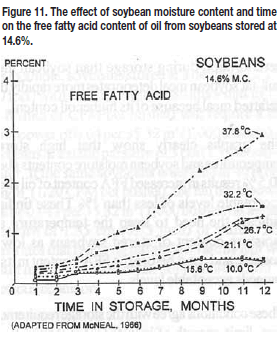Handling and Storage Of Soybeans and Soybean Meal: Part 4 - Chemical Changes In Storage


Chemical Changes In Storage
Stored soybeans may undergo physical, physiological and chemical changes even under ideal storage conditions. Some of the changes may or may not have a negative effect on the final use of soybeans and soybean meal depending on the degree of change. One common indicator of chemical change in stored soybean is the level of free fatty acid (FFA) present. An increase of FFA above 1% may translate into lower quality of its oil content. The effect of temperature and moisture on FFA content in soybeans is shown in Figures 9, 10 and 11. Other important changes include decline in soybean seed viability, change in the grain color, increase or decrease in its moisture, decomposition of phospholipid, and the denaturation of it protein. Soybean grain is more resistant to deterioration during storage than soybean meal. Full-fat soybean meal deteriorates more rapidly than defatted meal because of its higher oil content. The graphs clearly show that high storage temperatures and soybean moisture contents above 10.5% results in increased FFA content of oil above acceptable levels of less than 1%. These findings indicate the need to keep the temperature and moisture content of stored soybeans as low as possible and use it before the FFA content in its oil exceeds acceptable levels.
These conditions agree with the storage requirements that limit growth of insects and molds in stored soybeans (see the mold envelope and seed wet-bulb temperatures in Figure 6). At a moisture level of 10.5% or less, soybeans can be stored at any ambient temperature without molding problem. However, insects may still grow and multiply at relative humidities above 60%.
Handling and Storage Of Soybeans and Soybean Meal: Part 2 - Factors Affecting Safe Product Storage
Handling and Storage Of Soybeans and Soybean Meal: Part 3 - Deterioration Indicators
Handling and Storage Of Soybeans and Soybean Meal: Part 5 - Maintenance Of Quality
Handling and Storage Of Soybeans and Soybean Meal: Part 6 - Summary




